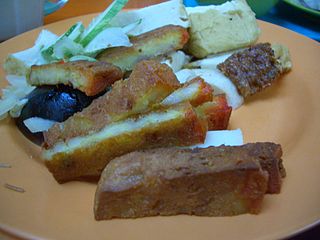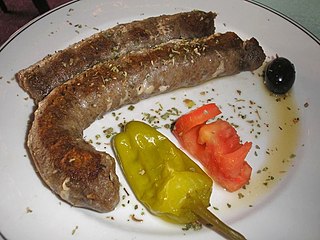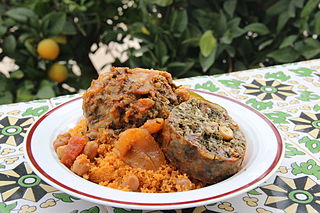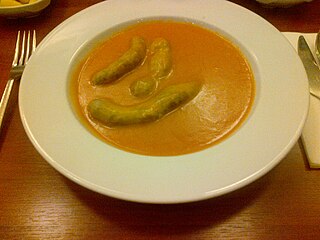Related Research Articles

A sausage is a type of meat product usually made from ground meat—often pork, beef, or poultry—along with salt, spices and other flavourings. Other ingredients, such as grains or breadcrumbs may be included as fillers or extenders.

Gravy is a sauce often made from the juices of meats that run naturally during cooking and often thickened with wheat flour or corn starch for added texture. The gravy may be further coloured and flavoured with gravy salt or gravy browning or ready-made cubes and powders can be used as a substitute for natural meat or vegetable extracts. Canned and instant gravies are also available. Gravy is commonly served with biscuits, roasts, meatloaf, rice, noodles, chips (fries) and mashed potatoes.

Tripe is a type of edible lining from the stomachs of various farm animals. Most tripe is from cattle, pigs and sheep.

A blood sausage is a sausage filled with blood that is cooked or dried and mixed with a filler until it is thick enough to solidify when cooled. Most commonly, the blood of pigs, sheep, lamb, cow, chicken, or goose is used.

Chorizo (, from Spanish [tʃoˈɾiθo]; Portuguese chouriço[ʃo ˈɾisu] is a type of pork sausage originating from the Iberian Peninsula. It is made in many national and regional varieties in several countries on different continents. Some of these varieties are quite different from each other, occasionally leading to confusion or disagreements over the names and identities of the products in question.

Offal, also called variety meats, pluck or organ meats, is the internal organs of a butchered animal. The word does not refer to a particular list of edible organs, and these lists of organs vary with culture and region, but usually exclude skeletal muscle. Offal may also refer to the by-products of human meat or of milled grains, such as corn or wheat.

Meze is a selection of small dishes served as appetizers in Albanian cuisine, Armenian, Levantine, Turkish, Greek, Iraqi, Egyptian, Balkan, Caucasian and Persian cuisine, to name a few. It is similar to Spanish tapas and Italian antipasti. A mezze may be served as a part of a multi-course meal or form a meal in itself. In non-Islamic countries, or in areas without alcohol restrictions, mezze are often served with spirits such as arak or grappa.

A chipolata is a type of fresh sausage, likely created in France. Sausages by that name appear in the 1903 edition of Escoffier's Le guide culinaire. Chipolatas are often prepared as a relatively thin and short sausage.

Bulgarian cuisine is part of the cuisine of Southeast Europe, sharing characteristics with other Balkan cuisines. Bulgarian cooking traditions are diverse because of geographical factors such as climatic conditions suitable for a variety of vegetables, herbs, and fruit. Aside from the vast variety of local Bulgarian dishes, Bulgarian cuisine shares a number of dishes with Persian, Turkish, and Greek cuisine.

Balearic cuisine is a Mediterranean cuisine as cooked in the Balearic Islands, Spain. It can be regarded as part of a wider Catalan cuisine, since it shares many dishes and ingredients with Catalonia and the Valencian Community. Others view it as part of a more global Spanish cuisine. Traditional Balearic cuisine is rich in vegetables, cereal and legumes as well as being low in fats. A succinct selection of the primary dishes would be ensaimades, seafood and vegetable stews, sobrassada, coques, tombet, Maó cheese and wine.

Ngo hiang, also known as heh gernglor bak or kikiam is a unique Hokkien and Teochew dish widely adopted in Indonesia, Malaysia, the Philippines, Singapore, and Thailand; in addition to its place of origin in southern China.

Loukaniko is a type of Greek sausage made from pork or lamb and typically flavored with orange peel, fennel seed, and various other dried herbs and seeds, and sometimes smoked over aromatic woods. They are also often flavored with greens, especially leeks.

Usban is a traditional kind of sausage in some North African countries such as Algeria, Tunisia, and Libya, stuffed with a mixture of rice, herbs, lamb, chopped liver and heart. This dish is usually served alongside the main meal of rice or couscous, often on special occasions.

Llapingachos are fried potato pancakes that originated in Ecuador. They are usually served with salsa de maní, a peanut sauce. The potato patties or thick pancakes are stuffed with cheese and cooked on a hot griddle until crispy brown.

A full breakfast is a substantial cooked breakfast meal, often served in the United Kingdom and Ireland, that typically includes bacon, sausages, eggs, black pudding, baked beans, tomatoes, mushrooms, toast, and a beverage such as coffee or tea. It appears in different regional variants and is referred to by different names depending on the area. While it is colloquially known as a "fry-up" in most areas of the United Kingdom and Ireland, it is usually referred to as a "full English", a "full Irish", "full Scottish", "full Welsh", and "Ulster fry", in England, the Republic of Ireland, Scotland, Wales, and Northern Ireland, respectively.

Wurstsalat is a tart sausage salad prepared with distilled white vinegar, oil and onions. A variation of the recipe adds strips of pickled gherkin. It is generally made from boiled sausage like Lyoner, stadtwurst, Regensburger Wurst or extrawurst. It is a traditional snack in Southern Germany, Alsace, Switzerland and Austria.

Sinangag, also called garlic fried rice or garlic rice, is a Filipino fried rice dish cooked by stir-frying pre-cooked rice with garlic. The rice used is preferably stale, usually leftover cooked rice from the previous day, as it results in rice that is slightly fermented and firmer. It is garnished with toasted garlic, rock salt, black pepper and sometimes chopped scallions. The rice grains are ideally loose and not stuck together.

Stuffed intestines ,is a dish of Middle Eastern origin called Bumbar/Mumbar. The main ingredients are minced meat, cow or lamb's intestines, rice, tomato paste, onion, chickpeas, salt, black pepper, allspice, and cinnamon.

Black pudding is a distinct regional type of blood sausage originating in the United Kingdom and Ireland. It is made from pork or beef blood, with pork fat or beef suet, and a cereal, usually oatmeal, oat groats, or barley groats. The high proportion of cereal, along with the use of certain herbs such as pennyroyal, serves to distinguish black pudding from blood sausages eaten in other parts of the world.
References
- ↑ Wright, Clifford A. (1999-10-20). A Mediterranean Feast: The Story Of The Birth Of The Celebrated Cuisines Of The Mediterranean, From The Merchants Of Venice To The Barbary Corsairs, With More Than 500 Recipes . Harper Collins. p. 68. ISBN 978-0-688-15305-2.
- ↑ Kaptan, Şükrü Tekin (1988). Denizli'nin halk kültürü ürünleri: bölgesel folklor karakterleri. Ş.T. Kaptan.